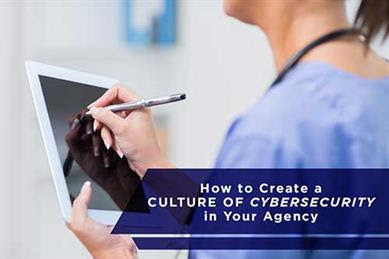Protecting patient information is of paramount importance to all health care organizations. Patient records include a great deal of data that is attractive to cybercriminals, making it vital that organizations find ways to protect and secure that data while still ensuring it is accessible to those individuals who need it in order to do their jobs.
While most organizations rely on technological methods of protecting their data, including antivirus software, intrusion protection systems, encryption, and more, all of the technology in the world will not be effective if you ignore the human element. The fact is, even with sophisticated cybersecurity protocols in place, many data breaches are caused by human error or action.
Some of the most newsworthy breaches of the last few years have been attributable to individuals making mistakes: leaving a company laptop unsecured, responding to a phishing email, compromising a password. For this reason, one of the best ways to ensure that your agency is able to fully protect sensitive data and remain in compliance with data protection rules is to create a culture of cybersecurity within your agency.
What Is a Culture of Cybersecurity?
If you were to ask your employees to explain what security means to them, what kind of response would you get? Would people shrug and tell you that they just do their jobs, and assume that everything is protected by the IT people? Or would they be able to clearly articulate why security is important to your organization, and what role they play in keeping your company safe from hackers, viruses, and other threats?
Clearly, the second option is preferable. A culture of security is one in which everyone understands the potential threats that face your organization, and their own role in ensuring that the company and its employees remain safe. This doesn’t mean that everyone needs to be an expert in cyber security.
That’s not realistic, given that the majority of your employees were not hired for any type of security function. What it does mean, though, is that you need to train your employees in such a way that they understand their role in security, and make it clear that your organization values security.
Training and Beyond
One of the most common reasons that security awareness training fails is that it’s not delivered on the principle of “we’re all in this together.” Often, security is managed in a way that is threatening or even demeaning — “do this or else you will be fired.” Instead of creating an environment where employees feel like they are part of a team, they instead feel fearful and disrespected, and may even be less compelled to comply with all of the security rules.
For that reason, security awareness and training needs to be approached in such a way that it is engaging, and shows employees what exactly is at stake. Make security training relevant to them; when they have an emotional investment in protecting data and networks, they will do whatever they can to get it done.
On a more practical level, specific steps you can take include:
- Training. Security training is not something that can be done once and checked off the list. It needs to be ongoing, and comprehensive in order to keep employees on top of new and emerging threats and to meet federal guidelines related to data protection.
- BYOD policies. BYOD helps improve the efficiency of your agency. When employees can access your patient management tools via mobile devices, they can be more productive and provide better care. However, BYOD also presents some security risks. A comprehensive policy relating to the security of personally-owned devices, as well as a management strategy to contain any risks should the device be infected with malware, lost, or stolen, gives employees the freedom they need to do their jobs while also protecting data.
- Set security goals. Again, your employees weren’t hired to handle security. Therefore, making your security expectations too complex or all-encompassing can have the effect of overwhelming employees. Instead, focus on specific goals and behaviors that align with your business goals, and give employees the tools they need to meet them.
- Incorporate reward and recognition. Rewards can be a powerful motivator for encouraging desired behaviors. Including a reward component for demonstrating desired security behaviors and practices can help support your culture.
- Enforce policies. One reason that security policies often fail is that they aren’t enforced. Put rules in place that limit access to data. Require password management. Address violations to policies when you learn of them. When employees know that violations will be addressed, they are less likely to take risks.
- Model organizational security awareness. Finally, recognize that security culture extends from the top down. Leaders must model the behaviors they want to see, and demonstrate that security is a priority in their work, too.
Creating a culture of security is one of the most important things that your agency can do to ensure that data is protected and you avoid costly data breaches. By giving everyone a role in that effort, you’ll undoubtedly have a more secure network.
To learn more about tools that can help improve productivity while maintaining the highest levels of security, check out some of Complia Health’s resources here.




